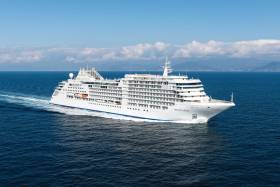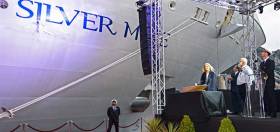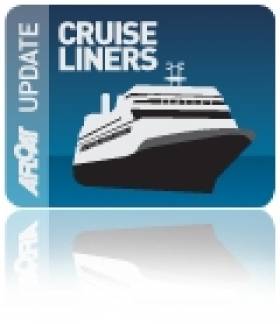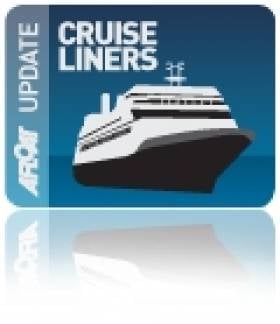Displaying items by tag: Silversea Cruises
New Flagship: Silver Muse Makes Maiden 'Irish' Port of Call
#cruiseliners - A brand new flagship Silver Muse made her maiden 'Irish' port of call off Dunmore East, Co. Waterford today, writes Jehan Ashmore.
Silver Muse introduced into service this summer, had sailed overnight from Falmouth in the UK and anchored offshore of Dunmore East having embarked a pilot.
The maiden call is a coup for the Port of Waterford in a season that is drawing to a close. Only one more cruiseship is scheduled next week, when Nautica of Oceania Cruises calls but berthing to Belview Port.
Guests on board the 212m newbuild built in Italy, Fincantieri's yard in Genoa, are visiting the local attractions in a region that has also in recent times been marketed as Ireland's Ancient East.
As previously reported on Afloat, Silver Muse was christened at a lavish ceremony in Monte Carlo, Monaco, where owners Silversea Cruises have their headquarters.
The 40,700 gross tonnage ultra luxury cruiseship is the latest in Silverseas 9-strong fleet which operates at the high-end of the market. The newbuild is an evolution of their Silver Spirit class which elevates the luxury brand to new levels.
Accommodating just 596, the personalised service is to such a high level that there are nearly one crew member for every guest as they are referred as not passengers.
Among the facilities is an exclusive Zàgara Beauty Spa, casino, gym, a 327-seat theatre, eight dining venues and a swimming pool. In addition to offering guests the highest number of large suites in the Silversea fleet, and with the greatest number of connecting suites.
Tommorow it will be the turn of Cork Harbour to welcome the newcomer when Silver Muse is to berth not at Cobh but at the nearby Ringaskiddy deepwater berth. One of the reasons been is due to the call of the considerably larger Regal Princess, operated by Princess Cruises and accommodating around 3,500 passengers.
In season 2018, an example of an Irish based cruise sailing direct from Dubin takes place on 13 May, to Barcelona. The 13 day cruise is availavle with fares from €6,500 (per guest).
Silver Muse Christened in Monaco Before Venetian Society Cruise
#MonacoCeremony - Prince Albert II of Monaco attended Silversea Cruises christening ceremony of their new flagship Silver Muse in the principality, before a pre-inaugural cruise to Greece begins next week, writes Jehan Ashmore.
As previously reported, Afloat had identified Silver Muse is to make an Irish debut later this season with a call to Waterford (Dunmore East) in September. The 40,700 tonnes cruiseship with just 596 passengers are accommodated in ultra luxurious facilities and pampered by a crew total of 411. The newest cruiseship of the 9-strong Silversea fleet is also to be make a first call to Cork.
The Italian built cruiseship from Fincantieri's yard in Genoa, will operate at the top end of the market. Among the facilities is an exclusive Zàgara Beauty Spa, casino, gym, a 327-seat theatre, eight dining venues and a swimming pool. In addition to offering guests the highest number of large suites in the Silversea fleet, and with the greatest number of connecting suites.
At the red-carpet christening ceremony held last Wednesday at the outer pier of Port Hercule, the glamorous harbour of Monte Carlo saw Silver Muse officially named by Constanza Lefebvre. The daughter of Silversea chairman Manfredi Lefebvre d'Ovidio, was watched by dignitaries and invited guests during the traditional ship’s blessing and champagne bottle-breaking at the bow.
The newcomer is an exciting evolution of their Silver Spirit class and the location of Monaco was chosen for the ceremony as Silversea has its headquarters in Monte Carlo. At the quayside were performances by the Sinfonietta Orchestra of Rome and renowned violinist Charlie Siem.
Silver Muse is to depart from Villefranche neighbouring Nice next Wednesday (3 May) on a ‘Venetian Society Inaugural Cruise’.
Afloat has consulted that the 13-day cruise of Mediterranean gems among them Portofino, Amalfi, Santorini, Kusadasi in Turkay and end in Piraeus, the port for Athens. Fares for society members only are from €8,250 per person based in a Classic Veranda Suite on Deck 5/6.
Twiggy’s Cruiseship Calls to Town
#COBH CRUISE CALL – The sleek profile of Seabourn Sojourn, the cruiseship whose godmother is Twiggy, the English fashion icon and actress, called at Cobh Cruise Terminal this morning, writes Jehan Ashmore.
The ultra-luxurious vessel is the second of a pair of 32,000 tonnes sisters built for Seabourn Cruises by Italian shipyard T. Marrioti in Genoa. She was launched into the Ligurian Sea in 2010 and unusually for a cruiseship she has twin funnels that skilfully merge into the superstructure's appearance.
In the same year the 197m vessel made a promotional visit to London where she was christened by Twiggy at a ceremony held on the Thames.
Seabourn Cruises operate in the top end of the cruise market and have won prestigious travel awards over the years. Likewise to competitor Silverseas Cruise whose Silver Whisper is visiting Killybegs today having made a port of call to Foynes yesterday.
The 450 guest capacity Seabourn Sejourn is also in the same league with her rivals in that she only has suites in terms of accommodation type, where within there is a choice of six categories.
She has 225 ocean view suites measuring 295 to 1,682 sq ft, 90% with private verandas. This includes five Owner's Suites measuring up to 1,062 sq ft (including the veranda) and four two-bedroom Grand Suites with up to 1,682 sq ft of private living space.
In addition there are 22 Penthouse Suites on the uppermost decks, each featuring up to 534 sq ft feet of space. To browse a virtual tour of these very spacious suites on Deck 11 click HERE.
As for facilities she sports the largest spa on any ultra-luxury ship, at 11,400 sq ft encompassing an indoor and outdoor space laid out over two decks. There are also six whirlpools and two swimming pools, including the pool patio, with a pair of large whirlpool spas and a "beach" style pool, a casual patio grill and the patio bar.
On the sun deck above sits Seabourn's popular open-air Sky Bar located high atop on deck 11 is a Sun Terrace with 36 tiered double sun beds. Just aft of that is The Retreat, with shuffleboard courts and a nine-hole putting green.
The panoramic Observation Bar on Deck 10 offers 270 degree forward views over the sea. There is the Club for dancing and the larger Grand Salon is also used for dancing as well as lectures, production vocal shows, cabaret performances and classical recitals.
Other facilities can be viewed through the virtual tour HERE
Cruiseships Head for Isle of Man
#MANX CRUISE CALLS – The Manx capital is set to welcome over a dozen cruise callers for the season which starts next month according to www.visitisleman.com
Two of the 14 calls that are scheduled to Douglas belong to the Silversea Cruises fleet, the Silver Cloud due in June, has been a fairly frequent visitor to the Isle of Man in the past. While the company's recently acquired 'Expedition' vessel Silver Explorer will be visiting the Island for the first time earlier in May.
Other distinctive inaugural callers in 2012 include the Seven Seas Voyager. The Berlitz Guide rated luxury premium class vessel is also scheduled to visit Douglas again the following year.
In addition to the 2012 season, the Thomson Spirit is due to call in early September, a vessel with a 1,250 passenger capability.
Below is the 2012 cruise call list
Quest for Adventure, 8th May
Arion, 26th May
Discovery, 28th May
Silver Explorer, 31st May
Marco Polo, 4th June
Ocean Countess, 5th June
Seven Seas Voyager, 7th June
Silver Cloud, 8th June
Saga Sapphire, 4th July
Quest for Adventure, 9th July
Marco Polo, 16th July
Deutschland, 20th July
Hebridean Princess, 21st August
Thomson Spirit, 6th September



























































